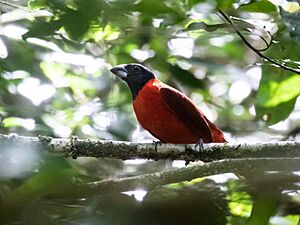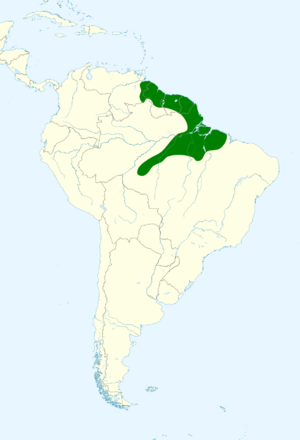Red-and-black grosbeak facts for kids
Quick facts for kids Red-and-black grosbeak |
|
|---|---|
 |
|
| Conservation status | |
| Scientific classification | |
| Genus: |
Periporphyrus
|
| Species: |
erythromelas
|
 |
|
| Approximate range | |
The red-and-black grosbeak (Periporphyrus erythromelas) is a colorful bird found in parts of South America. It belongs to the Cardinalidae family, which includes cardinals and other grosbeaks. This bird is known for its striking red and black feathers. You can find it in countries like Brazil, French Guiana, Guyana, Suriname, and Venezuela.
Contents
About Its Name
Have you ever wondered how scientists give names to animals? It's called Taxonomy. The red-and-black grosbeak got its official name in 1789 from a German scientist named Johann Friedrich Gmelin. He first put it in a group called Loxia.
The name erythromelas comes from ancient Greek words. Eruthros means "red" and melas means "black". So, the name perfectly describes its colors! Later, in 1850, another German scientist, Ludwig Reichenbach, placed it in its current group, Periporphyrus. This bird is unique, meaning it doesn't have different types or subspecies.
What Does It Look Like?
The red-and-black grosbeak is about 20.5 centimeters (about 8 inches) long. That's about the length of a standard pencil! One male bird weighed about 48 grams (1.7 ounces), which is lighter than a tennis ball.
Both male and female grosbeaks have a thick, black beak. Their entire head, including their throat, is also black.
Male and Female Colors
The male bird is very bright. Its neck, chest, and belly are a vibrant red. Its back is a deep, rich red color.
The female bird has different colors. Her upper body is a dark greenish-yellow. Her belly and chest are a yellowish-green. Young male birds look similar to adult males but their colors are not as bright.
Sounds It Makes
Both male and female red-and-black grosbeaks sing a "sweet series of halting phrases." This means their song is gentle and has short, clear parts. They also make a sharp "spink" sound as a call.
Where Does It Live?
The red-and-black grosbeak mostly lives in eastern Venezuela. From there, it spreads east through countries like Guyana, Suriname, and French Guiana. It also lives in northern Brazil. Sometimes, it's even seen south of the Amazon River in Brazil.
This bird likes to live in old, wet forests. These are called terra firme forests and várzea forests. You can find them from sea level up to about 1,000 meters (3,300 feet) high.
How Does It Behave?
Feeding Habits
The red-and-black grosbeak looks for food in the lower parts of the forest. It eats small creatures like arthropods (think insects and spiders) and seeds. Unlike some birds, it doesn't usually join big groups of different bird species to find food. Instead, it prefers to eat in pairs or with its family.
Reproduction and Life Cycle
Scientists don't have much information about how the red-and-black grosbeak breeds. We don't know when they lay eggs or how they raise their young yet. More research is needed to learn about their family life!
Is It Endangered?
The IUCN (International Union for Conservation of Nature) checks on animals around the world. They have said that the red-and-black grosbeak is of "Least Concern." This means that it is not currently in danger of disappearing. Between 2012 and 2018, it was thought to be "Near Threatened," but its situation has improved.


